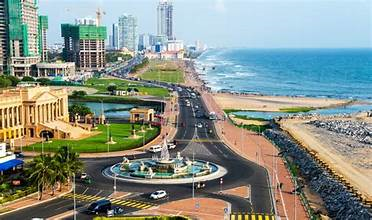…Colombo Fort and Pettah…
Colombo Fort & Pettah: A Glimpse into Sri Lanka’s Historical and Cultural Heart
Colombo, the bustling capital of Sri Lanka, is home to a fascinating mix of old and new, where colonial-era history seamlessly blends with modern development. At the heart of this urban landscape are two of its most iconic districts: Colombo Fort and Pettah. Both areas are rich in history, culture, and commerce, and they offer an immersive experience into the vibrant life of the city.
Colombo Fort: A Legacy of Colonial Power
Historical Significance
Colombo Fort, as the name suggests, was originally a fortified city built during Sri Lanka’s colonial era. The Portuguese were the first European power to establish a fort in the area in the early 16th century after arriving on the island. They used Colombo as a strategic port for trade and defense. Later, in the 17th century, the Dutch expanded and strengthened the fortifications, adding a more formal layout and creating a bustling European-style settlement within its walls.
By the late 18th century, the British took control of Colombo, and the fort area evolved into the administrative and commercial hub of the island. Though much of the original fortifications have disappeared over time, some remnants and colonial buildings still stand today, giving visitors a sense of the area’s past importance.
Modern Colombo Fort
Today, Colombo Fort is no longer a military structure, but it remains a key area in the city. It houses important government institutions, major banks, and corporate offices. The streets are lined with colonial-era buildings such as the Old Parliament Building, a neoclassical structure that now serves as the Presidential Secretariat, and the Cargills & Millers Building, which was once the headquarters of a major colonial trading company.
One of the most famous landmarks in Fort is the Colombo Clock Tower, which originally served as a lighthouse in the 19th century. The Galle Face Green, a large seaside promenade on the edge of the Fort area, offers a peaceful escape with views of the Indian Ocean and is a popular spot for locals and tourists alike.
Fort is also the starting point for Colombo’s Central Railway Station, connecting the capital to the rest of the island. Its grand architecture, reflective of its British colonial origins, still serves as a symbol of Colombo’s heritage.
Pettah: Colombo’s Bustling Bazaar
A Historic Market Hub
Located just east of Colombo Fort, Pettah is one of the oldest districts in the city and serves as its bustling commercial heart. The area is known for its chaotic streets, vibrant markets, and a dizzying variety of goods being sold at every corner. Pettah’s origins as a trading hub date back centuries, when merchants from across Asia and Europe came to the island to trade spices, textiles, and other goods.
Unlike the organized, colonial-style layout of Fort, Pettah is a maze of narrow streets and alleyways, each dedicated to a particular type of trade. The streets here teem with vendors selling everything from fresh produce, spices, and textiles to electronics, jewelry, and clothing.
Cultural Diversity
Pettah’s streets also reflect the incredible cultural diversity of Sri Lanka. Traders from different communities, including Sinhalese, Tamils, Muslims, and Malays, all contribute to the area’s vibrant atmosphere. This diversity is also visible in Pettah’s religious sites. For instance, the Jami Ul-Alfar Mosque, also known as the “Red Mosque,” is one of the most iconic landmarks in Pettah. Built in the early 1900s, this striking red-and-white striped mosque is a key place of worship for Colombo’s Muslim population.
Nearby, the Wolvendaal Church, a beautiful Dutch Reformed Church dating back to 1749, stands as a reminder of the area’s colonial past. Hindu temples and Buddhist shrines can also be found within Pettah, showcasing the interwoven nature of religious and cultural practices in the district.
The Pettah Market Experience
One of the main attractions of Pettah is its sprawling open-air market, known simply as the Pettah Market. Each street in Pettah has a specific specialty, such as Sea Street, renowned for its jewelry shops, or Second Cross Street, known for wholesale textiles. The market’s atmosphere is lively and vibrant, with vendors calling out to passersby and negotiating prices in a variety of languages.
Pettah Market is a sensory overload, with the smell of spices, the sight of colorful fabrics, and the sound of haggling buyers and sellers. For visitors, exploring Pettah is an adventure—each street offers something new, and the area’s maze-like structure adds to the excitement of discovering hidden shops or local eateries offering Sri Lankan street food.
Colombo Fort and Pettah Today
While Colombo Fort represents the formal, historical, and colonial side of Sri Lanka’s capital, Pettah provides a contrasting picture of the city’s commercial energy and cultural diversity. Together, these two districts embody the unique blend of past and present that characterizes Colombo.
Fort has become increasingly modernized, with new hotels, shopping complexes, and luxury developments reshaping its skyline, while Pettah retains much of its old-world charm, despite modern pressures.
For tourists, Colombo Fort and Pettah offer an ideal starting point to explore the city’s history and culture. Whether it’s strolling through the colonial buildings of Fort, watching the sunset at Galle Face Green, or losing oneself in the winding streets of Pettah’s markets, these areas provide a window into the heart of Colombo and its enduring legacy.
In many ways, Colombo Fort and Pettah together tell the story of Sri Lanka: a country that has been shaped by its colonial past, yet remains deeply rooted in its own rich cultural traditions, standing as a bridge between history and modernity.

